stop start VOLKSWAGEN PASSAT 2013 B8 / 6.G Owners Manual
[x] Cancel search | Manufacturer: VOLKSWAGEN, Model Year: 2013, Model line: PASSAT, Model: VOLKSWAGEN PASSAT 2013 B8 / 6.GPages: 379, PDF Size: 5.56 MB
Page 68 of 379

Preparation for the anti-theft alarm system
If the vehicle is pre-equipped for installation of the anti-theft alarm system, the alarm system can be
retrofitted by an authorized Volkswagen dealer or an authorized Volkswagen Service Facility.
The anti-theft alarm system makes it more difficult for someone to break into or steal the vehicle.
The anti-theft alarm system is automatically activated when the vehicle is locked by pressing the lock
button on the remote control vehicle key.
When is the alarm triggered?
The anti-theft alarm system sounds for about 30 seconds and the turn signals flash for up to 5 minutes
if the following occurs with respect to the locked vehicle:
�x Opening a door that has been mechanically unlocked without switching on the ignition within about
15 seconds.
�x Forcibly opening a door.
�x Forcibly opening the engine hood.
�x Forcibly opening the luggage compartment lid.
�x Switching on the ignition with an invalid key.
�x Disconnecting the vehicle battery.
Deactivating the alarm
Unlock the vehicle with the unlock button on the remote control vehicle key and switch on the ignition
with a valid vehicle key.
For vehicles with Keyless Access, the alarm can be deactivated by grasping one of the door handles
when a valid remote control vehicle key is in range or by holding the remote control vehicle key to the
right of the steering column trim and pressing the starter button.
After the alarm has stopped and the vehicle is opened again in the same or a different area that
is protected by the alarm, the alarm is triggered again. For example, the alarm will sound again if the
luggage compartment lid is opened after one of the doors has been opened.
The anti-theft alarm system is not activated when the vehicle is locked with the power lock
switch W on the inside of the driver or front passenger doors.
If the driver door is mechanically unlocked using the vehicle key bit, only the driver door is un-
locked, but not the entire vehicle. Switching on the ignition deactivates the anti-theft alarm system and
activates the central locking button. To unlock the doors, use the central locking button or remote
control vehicle key.
If the vehicle battery is dead or weak, the anti-theft alarm system will not work properly.
Page 102 of 379
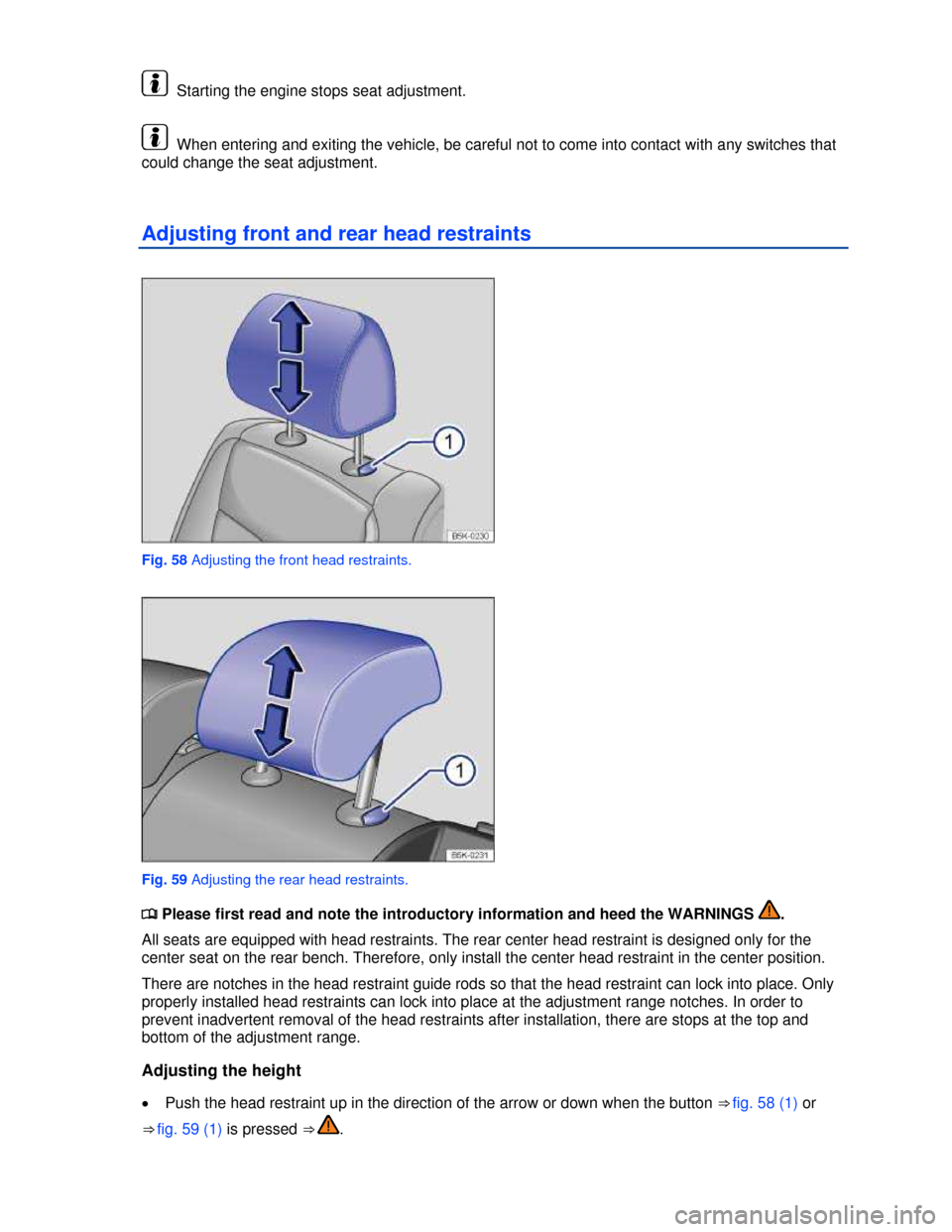
Starting the engine stops seat adjustment.
When entering and exiting the vehicle, be careful not to come into contact with any switches that
could change the seat adjustment.
Adjusting front and rear head restraints
Fig. 58 Adjusting the front head restraints.
Fig. 59 Adjusting the rear head restraints.
�
Page 176 of 379

WARNING
Improper use of the trailer hitch can cause accidents and injuries. An improperly installed,
incorrect, or damaged trailer hitch can cause the trailer to separate from the towing vehicle
and cause serious personal injuries.
�x Only use an undamaged, properly mounted trailer hitch.
�x Never repair or modify the trailer hitch.
�x To reduce the risk of injury in rear-end collisions, and the risk to pedestrians and cyclists
when the vehicle is parked, always remove the ball mount when you are not towing a trailer.
�x Never install a “weight distributing” or “load equalizing” trailer hitch on your vehicle. The
vehicle was not designed for these kinds of trailer hitches. The trailer hitch attachment can
fail, causing the trailer to tear loose from the vehicle.
WARNING
Improper trailer towing can cause loss of vehicle control and serious personal injury.
�x Driving with a trailer and carrying heavy or large things can change the way the vehicle
handles, increase the distance it needs to stop safely, and cause accidents.
�x Always secure the load properly with suitable and undamaged straps so that the load will
not shift.
�x Always adapt your speed and driving to the heavier load and the weight distribution in the
vehicle. Take road, weather, traffic, and visibility conditions into account as well.
�x Reduce your speed even more than you otherwise would when going downhill and under
unfavorable load, weather, or wind conditions.
�x Trailers with a high center of gravity tip more easily than trailers with a low center of gravi-
ty.
�x Always avoid sudden maneuvers and hard braking.
�x Be especially careful when passing other vehicles.
�x Reduce speed immediately if the trailer shows the slightest sign of swaying.
�x Never try to stop the swaying by accelerating.
�x Always obey speed limits. In some areas, the speed limits for vehicles towing trailers are
lower than for vehicles without trailers. Never drive faster than 50 mph (80 km/h; under ex-
ceptional circumstances 60 mph - 100 km/h) when towing a trailer. This applies even if the
local speed limit is higher.
If you are driving a new vehicle or a vehicle with a new or rebuilt engine, do not tow a trailer
during the break-in period, about 600 miles (1000 km).
If you tow a trailer, your vehicle may need maintenance more often because of the extra load it
has to move.
When you are not towing, remove the trailer hitch ball. This helps keep the trailer hitch from
causing damage to your vehicle and to others if your vehicle is hit from behind.
Some models need a trailer hitch to tow or tow-start other vehicles. You may want to always
carry the ball mount in the vehicle after it has been removed. Be sure to stow it securely.
Page 204 of 379
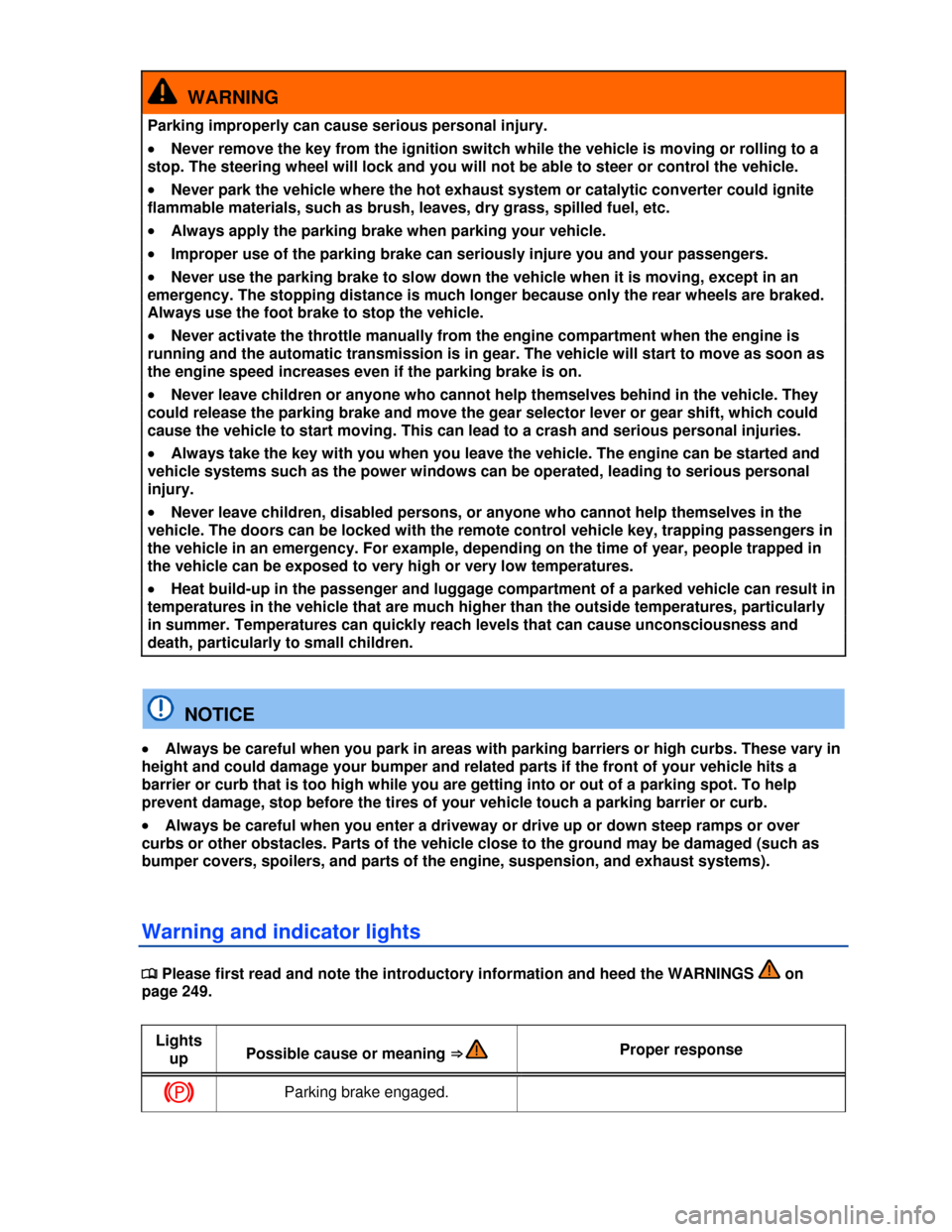
WARNING
Parking improperly can cause serious personal injury.
�x Never remove the key from the ignition switch while the vehicle is moving or rolling to a
stop. The steering wheel will lock and you will not be able to steer or control the vehicle.
�x Never park the vehicle where the hot exhaust system or catalytic converter could ignite
flammable materials, such as brush, leaves, dry grass, spilled fuel, etc.
�x Always apply the parking brake when parking your vehicle.
�x Improper use of the parking brake can seriously injure you and your passengers.
�x Never use the parking brake to slow down the vehicle when it is moving, except in an
emergency. The stopping distance is much longer because only the rear wheels are braked.
Always use the foot brake to stop the vehicle.
�x Never activate the throttle manually from the engine compartment when the engine is
running and the automatic transmission is in gear. The vehicle will start to move as soon as
the engine speed increases even if the parking brake is on.
�x Never leave children or anyone who cannot help themselves behind in the vehicle. They
could release the parking brake and move the gear selector lever or gear shift, which could
cause the vehicle to start moving. This can lead to a crash and serious personal injuries.
�x Always take the key with you when you leave the vehicle. The engine can be started and
vehicle systems such as the power windows can be operated, leading to serious personal
injury.
�x Never leave children, disabled persons, or anyone who cannot help themselves in the
vehicle. The doors can be locked with the remote control vehicle key, trapping passengers in
the vehicle in an emergency. For example, depending on the time of year, people trapped in
the vehicle can be exposed to very high or very low temperatures.
�x Heat build-up in the passenger and luggage compartment of a parked vehicle can result in
temperatures in the vehicle that are much higher than the outside temperatures, particularly
in summer. Temperatures can quickly reach levels that can cause unconsciousness and
death, particularly to small children.
NOTICE
�x Always be careful when you park in areas with parking barriers or high curbs. These vary in
height and could damage your bumper and related parts if the front of your vehicle hits a
barrier or curb that is too high while you are getting into or out of a parking spot. To help
prevent damage, stop before the tires of your vehicle touch a parking barrier or curb.
�x Always be careful when you enter a driveway or drive up or down steep ramps or over
curbs or other obstacles. Parts of the vehicle close to the ground may be damaged (such as
bumper covers, spoilers, and parts of the engine, suspension, and exhaust systems).
Warning and indicator lights
�
Page 207 of 379
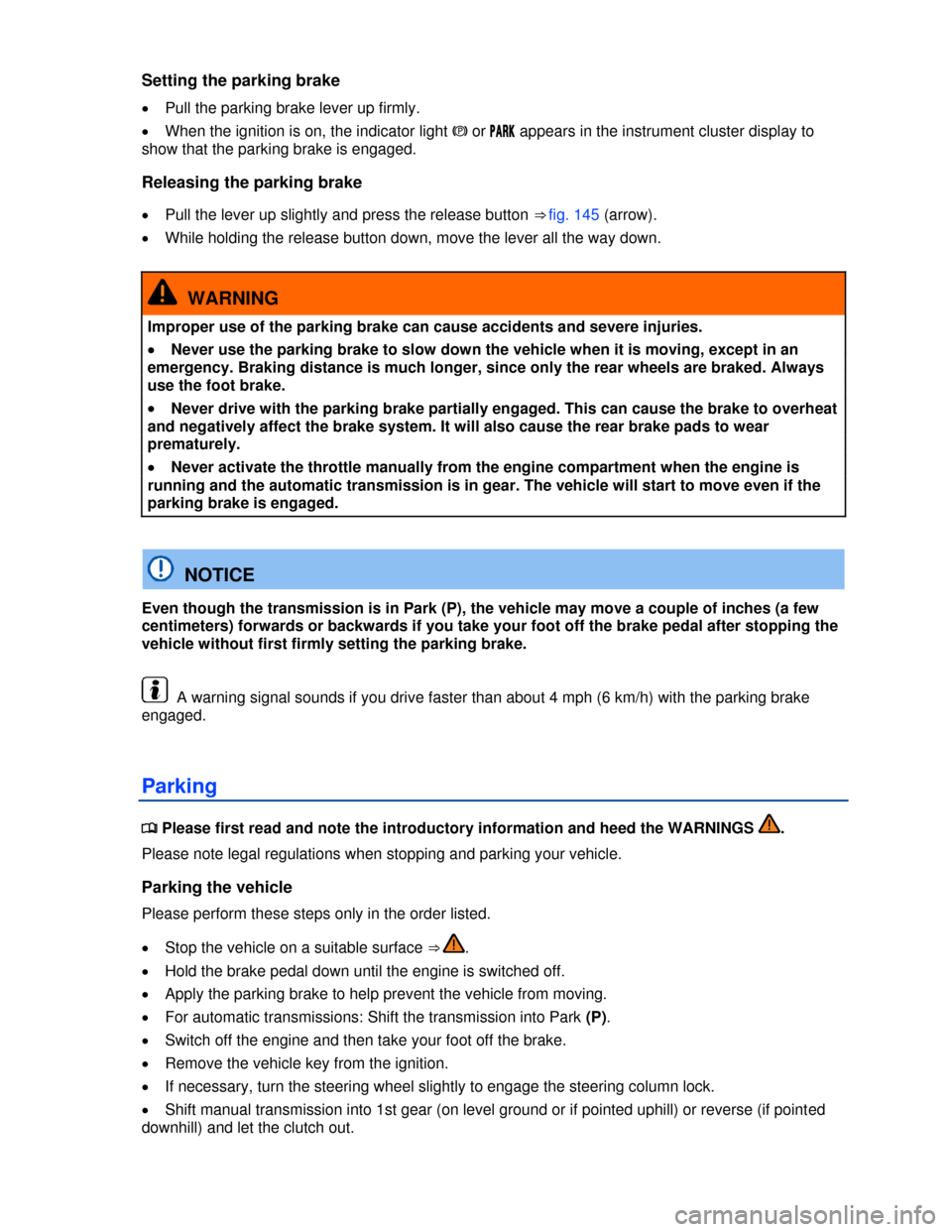
Setting the parking brake
�x Pull the parking brake lever up firmly.
�x When the ignition is on, the indicator light �G or �0�!�2�+ appears in the instrument cluster display to
show that the parking brake is engaged.
Releasing the parking brake
�x Pull the lever up slightly and press the release button ⇒ fig. 145 (arrow).
�x While holding the release button down, move the lever all the way down.
WARNING
Improper use of the parking brake can cause accidents and severe injuries.
�x Never use the parking brake to slow down the vehicle when it is moving, except in an
emergency. Braking distance is much longer, since only the rear wheels are braked. Always
use the foot brake.
�x Never drive with the parking brake partially engaged. This can cause the brake to overheat
and negatively affect the brake system. It will also cause the rear brake pads to wear
prematurely.
�x Never activate the throttle manually from the engine compartment when the engine is
running and the automatic transmission is in gear. The vehicle will start to move even if the
parking brake is engaged.
NOTICE
Even though the transmission is in Park (P), the vehicle may move a couple of inches (a few
centimeters) forwards or backwards if you take your foot off the brake pedal after stopping the
vehicle without first firmly setting the parking brake.
A warning signal sounds if you drive faster than about 4 mph (6 km/h) with the parking brake
engaged.
Parking
�
Page 208 of 379
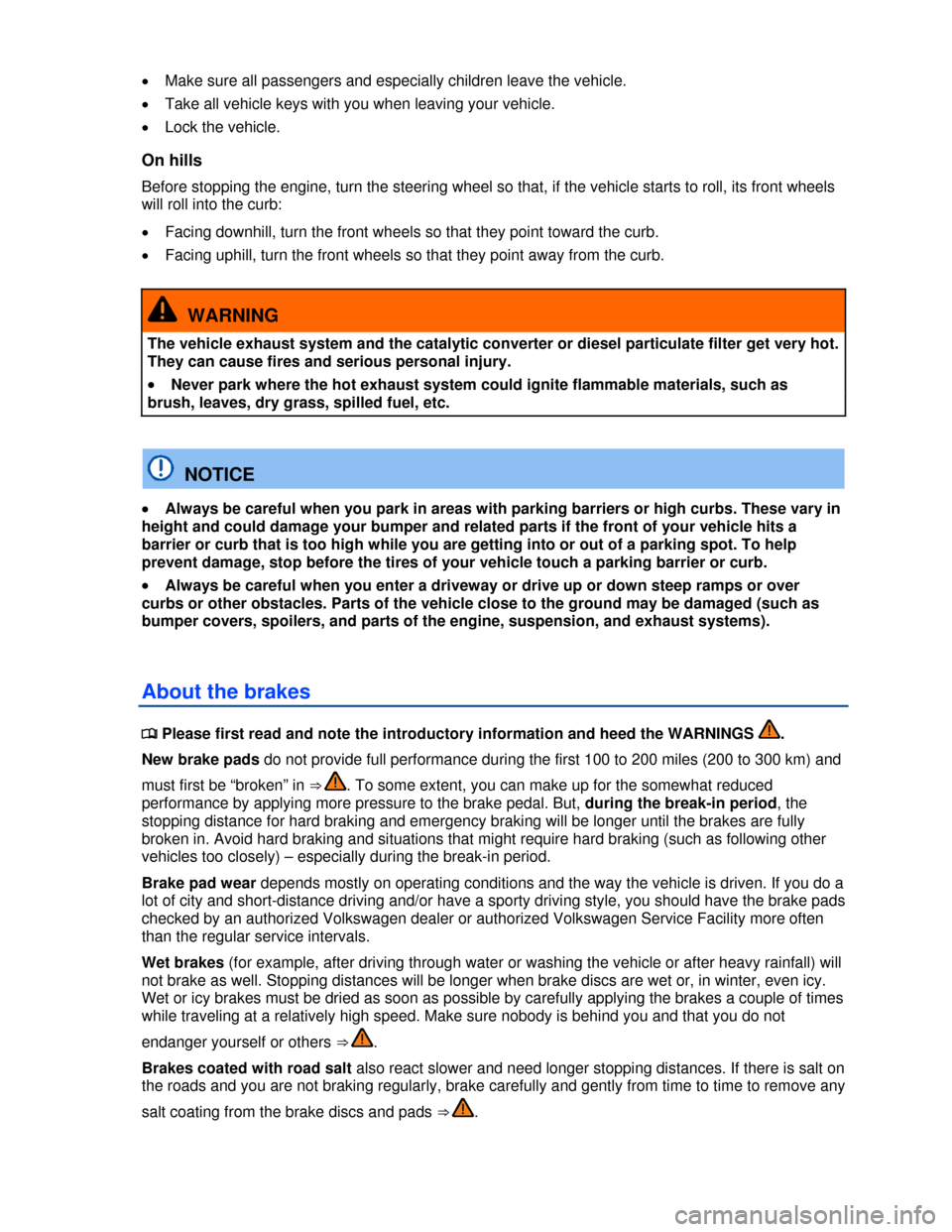
�x Make sure all passengers and especially children leave the vehicle.
�x Take all vehicle keys with you when leaving your vehicle.
�x Lock the vehicle.
On hills
Before stopping the engine, turn the steering wheel so that, if the vehicle starts to roll, its front wheels
will roll into the curb:
�x Facing downhill, turn the front wheels so that they point toward the curb.
�x Facing uphill, turn the front wheels so that they point away from the curb.
WARNING
The vehicle exhaust system and the catalytic converter or diesel particulate filter get very hot.
They can cause fires and serious personal injury.
�x Never park where the hot exhaust system could ignite flammable materials, such as
brush, leaves, dry grass, spilled fuel, etc.
NOTICE
�x Always be careful when you park in areas with parking barriers or high curbs. These vary in
height and could damage your bumper and related parts if the front of your vehicle hits a
barrier or curb that is too high while you are getting into or out of a parking spot. To help
prevent damage, stop before the tires of your vehicle touch a parking barrier or curb.
�x Always be careful when you enter a driveway or drive up or down steep ramps or over
curbs or other obstacles. Parts of the vehicle close to the ground may be damaged (such as
bumper covers, spoilers, and parts of the engine, suspension, and exhaust systems).
About the brakes
�
Page 212 of 379

XDL is an extension of the Electronic Differential Lock system. XDL does not react to drive wheel
slippage when driving straight ahead. Instead, XDL detects slippage of the inside front wheel during
fast cornering. XDL applies enough brake pressure to this wheel in order to stop the slippage. This
improves traction, which helps the vehicle stay on track.
WARNING
Driving fast on icy, slippery, or wet roads can lead to a loss of control and result in serious
personal injury for you and your passengers.
�x Always adjust your speed and driving style to road, traffic, weather, and visibility
conditions. Never let the additional safety that ESC, ABS, BAS, ASR, and EDL can provide
tempt you into taking extra risks.
�x Braking assistance systems cannot overcome the laws of physics and always prevent
loss of vehicle control. Slippery and wet roads are still dangerous even with ESC and the
other systems!
�x Driving too fast on wet roads can cause the wheels to lose contact with the road and
“hydroplane.” A vehicle that has lost road contact cannot be braked, steered, or controlled.
�x These systems cannot reduce the risk of accident, for example if you drive too fast for
conditions or if you do not keep your distance from the vehicle in front of you.
�x Although these systems are very effective and can help you control the vehicle in many
difficult situations, always remember that your vehicle handling control is limited by tire
traction.
�x When accelerating on a slippery surface, for example on ice and snow, depress the
accelerator carefully. Even with these systems, the wheels may start to spin, leading to a loss
of vehicle control.
WARNING
The effectiveness of ESC can be significantly reduced if other components and systems that
affect vehicle dynamics, including but not limited to brakes, tires, and other systems
mentioned above, are not properly maintained or functioning.
�x Always remember that vehicle alterations or modifications can affect the functioning of
the ABS, BAS, ASR, EDL, and ESC systems.
�x Changing the vehicle suspension or using an unapproved tire / wheel combination can
change the way the ABS, BAS, ASR, EDL, and ESC systems work and reduce their
effectiveness.
�x The effectiveness of ESC is also determined by the tires fitted.
All 4 wheels must be equipped with identical tires in order for ESC and ASR to work properly.
Differences in the tread circumference of the tires can cause the system to reduce the engine power
when it is not expected.
If ABS is not working, ESC, ASR, and EDL will also not work.
You may hear noises when these systems are active.
Page 222 of 379
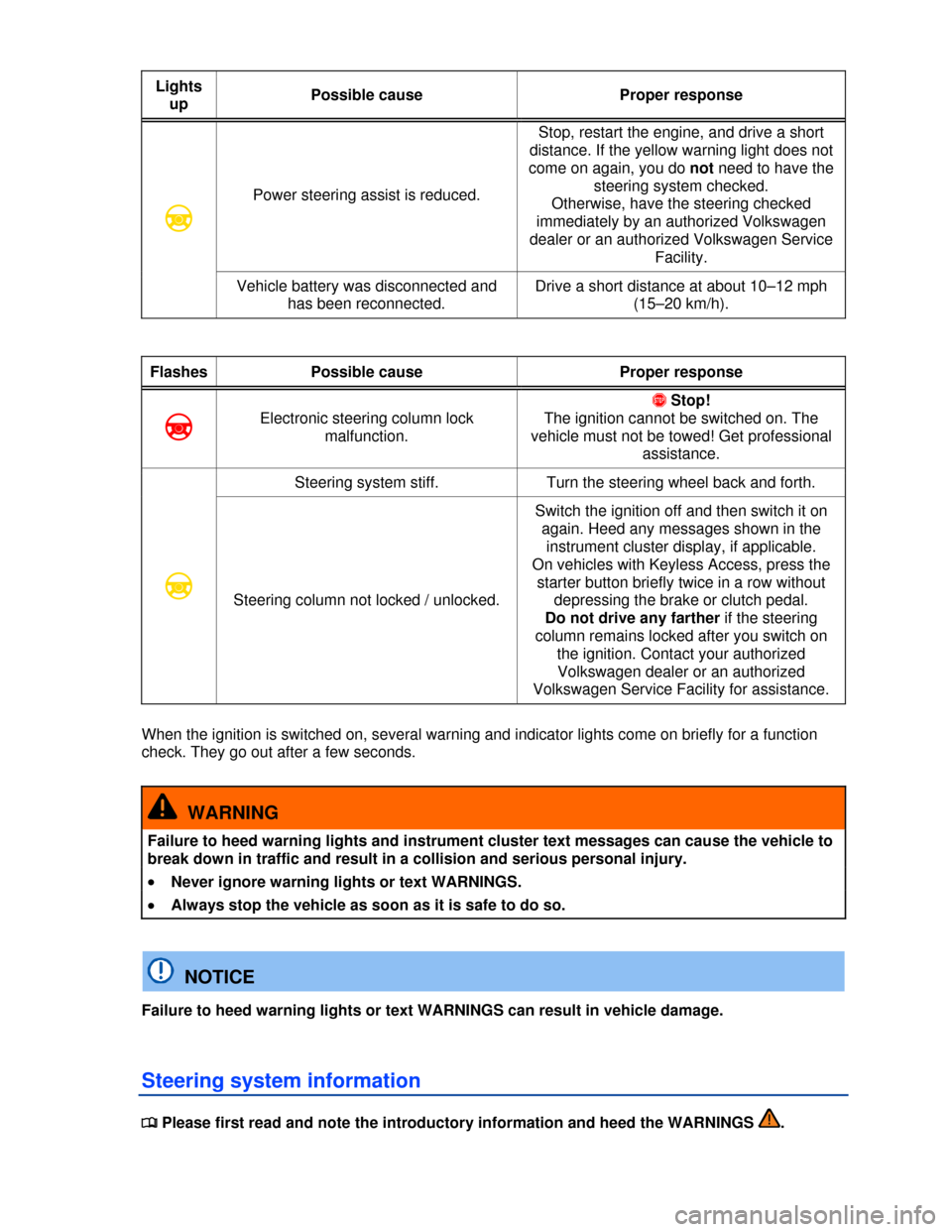
Lights
up Possible cause Proper response
�D
Power steering assist is reduced.
Stop, restart the engine, and drive a short
distance. If the yellow warning light does not
come on again, you do not need to have the
steering system checked.
Otherwise, have the steering checked
immediately by an authorized Volkswagen
dealer or an authorized Volkswagen Service
Facility.
Vehicle battery was disconnected and
has been reconnected.
Drive a short distance at about 10–12 mph
(15–20 km/h).
Flashes Possible cause Proper response
�D Electronic steering column lock
malfunction.
�
Page 225 of 379

Reverse (manual transmission) or in Drive (D), Sport Drive (S), or Reverse (R) (automatic
transmission) and you must use the foot brake to hold the vehicle before starting to move.
Hill Hold keeps the brake applied for not quite 2 seconds with the same force you used to prevent the
vehicle from moving. This gives you time to take your foot off the brake, let the clutch out on a manual
transmission vehicle, and gently depress the accelerator to get the vehicle moving again. If you do not
depress the accelerator pedal and get the vehicle moving again within this time, the brakes will release
and the vehicle will roll downhill. Furthermore, if any requirement for engaging Hill Hold is no longer
met while the vehicle is stopped, Hill Hold disengages and the brakes are automatically released and
will no longer hold the vehicle.
Hill Hold is activated automatically when the following conditions are all met at the same
time.
Points 1 to 3 must all be met at the same time:
Manual transmission Automatic transmission
1. Hold the stopped vehicle on an incline with the foot or parking brake.
2. The engine must be running “smoothly.”
3. A manual transmission vehicle must be in 1st
gear (1) if headed up a hill or in Reverse (R) if
backing up a hill; you must hold the clutch
down and the foot brake must be depressed to
keep the vehicle from moving.
An automatic transmission vehicle must be in
Reverse (R), Drive (D), or Sport Drive (S) and
the foot brake must be depressed to keep the
vehicle from moving.
4. To drive off take your foot off the brake pedal
as you let the clutch out and gently depress
the accelerator within 2 seconds.
To drive off take your foot off the brake pedal
and gently depress the accelerator within 2
seconds.
Hill Hold is immediately deactivated:
�x If any requirement listed in the table above is no longer met.
�x If the engine is not running smoothly or the engine malfunctions.
�x If the engine stalls or is switched off.
�x Automatic transmission vehicles: If the transmission is in Neutral (N).
�x Automatic transmission vehicles: If a tire does not have enough road contact (such as when the
vehicle is tipped or at an angle).
WARNING
The intelligent technology of Hill Hold cannot overcome the laws of physics. Never let the
increased convenience provided by Hill Hold tempt you into taking risks.
�x The Hill Hold feature cannot hold the vehicle in all hill start situations (for example, if the
surface is icy or slippery).
�x Hill Hold can only help keep the vehicle from moving for less than 2 seconds. After that,
the brakes will be released and the vehicle can roll down the hill.
Page 253 of 379
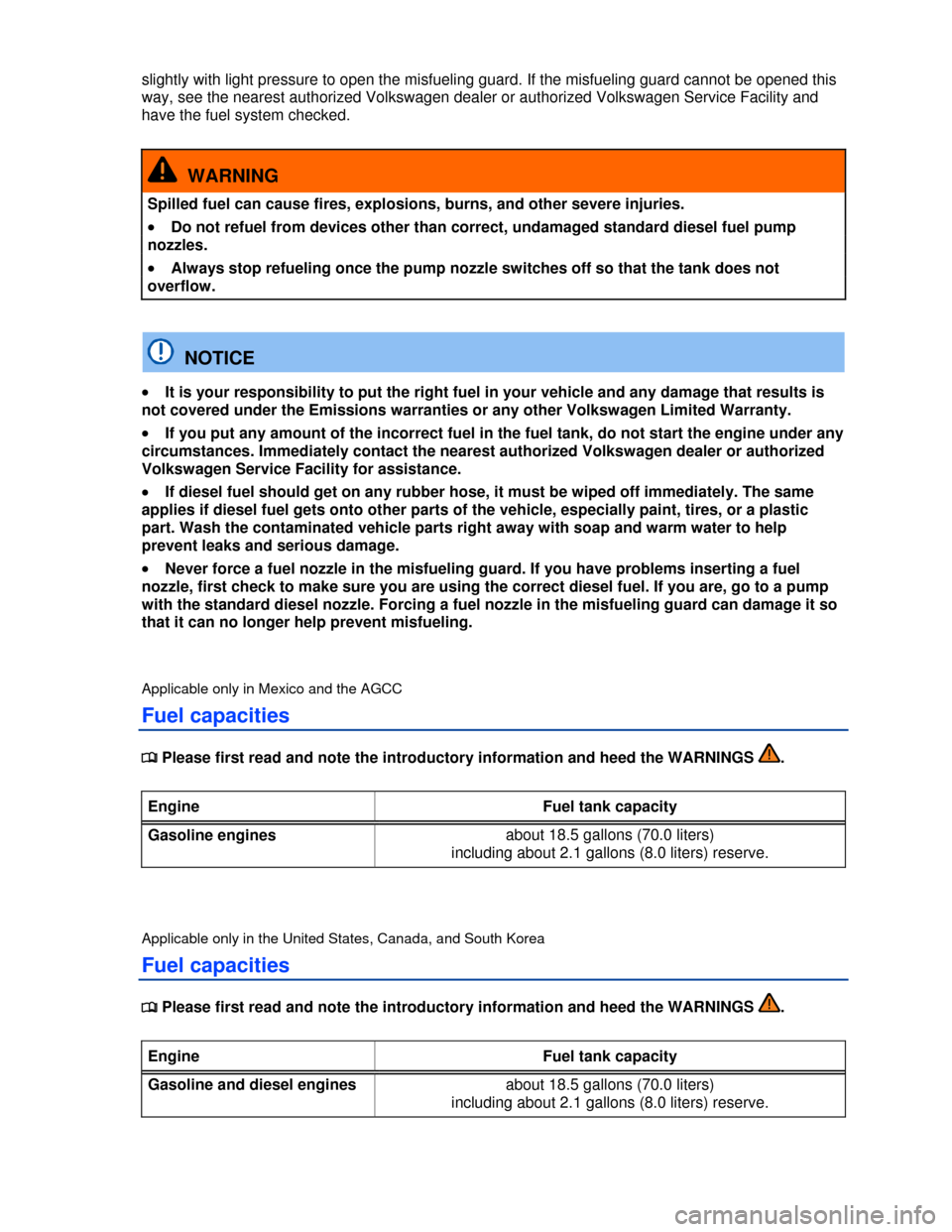
slightly with light pressure to open the misfueling guard. If the misfueling guard cannot be opened this
way, see the nearest authorized Volkswagen dealer or authorized Volkswagen Service Facility and
have the fuel system checked.
WARNING
Spilled fuel can cause fires, explosions, burns, and other severe injuries.
�x Do not refuel from devices other than correct, undamaged standard diesel fuel pump
nozzles.
�x Always stop refueling once the pump nozzle switches off so that the tank does not
overflow.
NOTICE
�x It is your responsibility to put the right fuel in your vehicle and any damage that results is
not covered under the Emissions warranties or any other Volkswagen Limited Warranty.
�x If you put any amount of the incorrect fuel in the fuel tank, do not start the engine under any
circumstances. Immediately contact the nearest authorized Volkswagen dealer or authorized
Volkswagen Service Facility for assistance.
�x If diesel fuel should get on any rubber hose, it must be wiped off immediately. The same
applies if diesel fuel gets onto other parts of the vehicle, especially paint, tires, or a plastic
part. Wash the contaminated vehicle parts right away with soap and warm water to help
prevent leaks and serious damage.
�x Never force a fuel nozzle in the misfueling guard. If you have problems inserting a fuel
nozzle, first check to make sure you are using the correct diesel fuel. If you are, go to a pump
with the standard diesel nozzle. Forcing a fuel nozzle in the misfueling guard can damage it so
that it can no longer help prevent misfueling.
Applicable only in Mexico and the AGCC
Fuel capacities
�